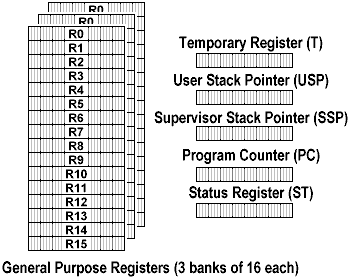
developer's mag
main page
article
part 1
part 2
part 3
part 4
part 5
part 6
part 7
part 8
part 9
2 - The Hardware

The CPU's registers fall into several categories. There are sixteen general-purpose registers, each of which is 32 bits long. The first seven (r0 through r6) have a privileged status, since more instructions can make use of them directly than for the other registers (although all 16 are addressable). There are three banks of these registers, with a single bank visible at a time, and selectable from software.
The t (temporary) register is similar to the accumulator in a CISC chip. Possibly the largest difference is that it is used in the various addressing and branch modes as well, where the value is added to the program counter (PC) to create a branch address. There are also two stack pointers, one the Supervisor Stack Pointer (SSP), and the other the User Stack Pointer (USP).
Previous Section
Next Section